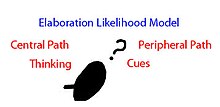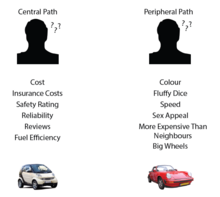User:Davidvfu1/sandbox
This article has multiple issues. Please help improve it or discuss these issues on the talk page. (Learn how and when to remove these template messages)
|
Introduction Creating Elaboration Likelihood Model[edit]

The elaboration likelihood model (ELM) of persuasion[1]Elaboration likelihood model (ELM) was developed by Richard E. Petty and John Cacioppo during the early 1980s. ELM is a theory about how attitudes are formed and changed. The theory states that there are two ways people make decisions; Central route processing and Peripheral route processing. ELM resembles the heuristic-systematic model of information processing developed about the same time by Shelly Chaiken.
Elaboration[edit]
To elaborate in ELM means to take time to really consider a decision and way up all options. In ELM there are two types of elaboration; Biased and objective.
Biased elaboration[edit]
Biased elaboration consists of top down thinking in which the receiver already has a pre-determined conclusion.
Objective elaboration[edit]
Objective elaboration consists of bottom up thinking. The receiver scrutinized all the facts involved in a decision and lets the facts speak for themselves. Facts are interpreted with an open mind and the receiver does not have a pre-determined outcome.
ELM Paths[edit]
The central path and the peripheral path are the two paths to persuasion which lie at the basis of the theory. [2]
Central Path[edit]
The central path is used when the receiving person cares about the issue at hand and is able to understand it without allowing themselves to be distracted by superficial information. The central path is more likely to leave a lasting persuasion on the receivers if the subject is sympathetic by them. If, however, the receivers of the message are unfavourably inclined towards it, then a boomerang effect (an opposite effect) is likely to occur.
Peripheral Path[edit]
The peripheral path is used when the receiver has little or no interest for the subject. In which case the message conveys peripheral hints to something that the chosen audience may already have a positive attitude towards. These hints can be targeted towards something as simple as pleasurable leisure activities or to something much more complex such as presenting the issue after several other positions to which the receiver is negatively inclined. The person maintains their initial attitude towards the matter if the peripheral signals are not accepted, if they are accepted, however, the person will temporarily change their attitude towards it. This attitude switch may lead to a permanent opinion change, however, this is less likely to happen than a decision made using the central route.
Path Choice[edit]
When making a decision, there is often not enough time or mental capacity to fully examine important aspects of persuasive arguments. In these occurrences, people tend to rely on other cues to make decisions.
Choice of route[edit]
The factors most influencing the route an individual will take in a persuasive situation are motivation (a desire to process the message; see Petty and Cacioppo, 1979) and ability (the capability for critical evaluation; see Petty, Wells and Brock, 1976). The route taken is determined by the extent of elaboration, in turn determined by motivation and ability factors. Motivation includes the relevance of the message and a person's "need for cognition" (their enjoyment of thought). Ability includes the availability of cognitive resources (e.g., the presence or absence of time pressures or distractions) and the relevant knowledge needed to examine the arguments. Distractions (for example, a persuader trying to convey a message in a room full of crying babies) can affect the ability to process a message. Examples of distractions impeding concentration on a message include a death in the family or relationship problems. A child will change their behavior because their parent told them to do so, rather than by processing information independently. As children grow they develop greater cognitive complexity, becoming able to process information centrally and draw conclusions of their own.[2] A subject's educational level, and their education and experience with the topic at hand, affect their ability to be persuaded. Under conditions of moderate elaboration, a mixture of central and peripheral route processes will guide information-processing. There are benefits and consequences of both processes. An individual who disagrees with the message being presented may boomerang if they centrally process the message and bounce away from the speaker’s goal. In a similar situation, a peripherally-processed message will have less of a negative effect on the individual.[2]
History[edit]
How attitudes are shaped and changed, Richard E. Petty and John T. Cacioppo in 1980 developed the Elaboration Likelihood Model (ELM) of persuasion.
The Elaboration Likelihood Model (ELM) is founded on hypothesise proposed by Leon Festinger in 1954. Leon Festinger said people are motivated to hold correct attitudes.
1980 Cacioppo and Petty stated the amount of elaboration that individuals are willing and able to invest in decision-making differs with the individual and the situation.
Shavitt & Brock, 1994 Central Route to Persuasion is marked by high elaboration. The act of developing something in detail the connections within information is defined as Elaboration.
Cafferata & Tybout, 1989 dependence on modest cues and environmental features of the message to make decisions and judgments this defines the Peripheral Route to Persuasion
Visual thinking understanding Elaboration Likelihood Model[edit]
Understand The Elaboration Likelihood Model better visual learners.
Image 1

Summary of above image David will use logical thinking and not take short cuts; he will read books and magazines. David is motivated and able to buy a car using all the best information he can find, he is not persuaded by the attractive girls.
Tom wants a car but he is not motivated to read books he is also able like David but he does not want to put in all the hours and hours of work David is by reading to find the best car in the market place. Therefor the attractive/sexy girls may persuade Tom to buy the car.
Image 2

Image 3

Image 4

Elaboration types[edit]
Attitude, motivation and ability increase the likelihood that a message will be ingrained into listeners' minds, although (as the social judgment theory suggests) they may not process information objectively. An attitude is a general evaluation, indicating how a person perceives themselves in relation to their surroundings. Attitudes may be influenced by peripheral cues providing guidance or implications, which cause the audience to draw a conclusion and believe it is their own idea.Cite error: A <ref> tag is missing the closing </ref> (see the help page).
Predictions and features[edit]
The ELM makes several proposals.Attitudes formed under high elaboration (the central route) are stronger than those formed under low elaboration, making this level of persuasion stable and less susceptible to counter-persuasion. Attitudes formed under low elaboration (the peripheral route) are more likely to cause short-term attitude change.
Variables in ELM routes can serve multiple roles in a persuasive setting, depending on other contextual factors. Under high elaboration, a given variable (e.g. expertise) can serve as an argument ("If Einstein agrees with the theory of relativity, then this is a strong reason for me to as well") or a biasing factor ("if an expert agrees with this position it is probably good, so let me see what else agrees with this conclusion", at the expense of contradicting information).
Under low-elaboration conditions, a variable may act as a peripheral cue (for example, the belief that "experts are always right"). While this is similar to the Einstein example above, this is a shortcut which (unlike the Einstein example) does not require thought. Under moderate elaboration, a variable may direct the extent of information processing: "If an expert agrees with this position, I should really listen to what (s)he has to say".
A variable's effect on elaboration may increase (or decrease) persuasion, depending on the strength of the argument. If the argument is strong, enhancing elaboration will enhance persuasion; if weak, thought will undermine persuasion.
Recent adaptations of the ELM Petty, R. E., Briñol, P., & Tormala, Z. L. (2002). Thought Confidence as a Determinant of Persuasion: The Self-validation Hypothesis. Journal of Personality & Social Psychology, 82, 722-741.have added an additional role for variables: to affect the extent to which a person trusts their thoughts in response to a message (self-validation role). A person may feel "if an expert presented this information, it is probably correct, and thus I can trust that my reactions to it are informative with respect to my attitude". This role, because of its metacognitive nature, only occurs in high-elaboration conditions.
Application of the theory[edit]
A group of psychologist have used the theory for a smoking awareness campaign. They have exposed students to the two approaches – the central and the peripheral. The students with lower need for cognition were persuaded by the emotion centered campaign and the students with higher need for cognition were persuaded by the fact centered campaign. The scientist not only proved that the elaboration-likelihood model is correct, but they have also transformed the way advertisement are designed.
See also[edit]
- Attitude change
- Need for cognition
- Cognitive biases
- Countersignaling
- Persuasion
- Heuristic-Systematic Model
- Extended transportation-imagery model
References[edit]
- Eagly, A. H., & Chaiken, S. (1993). Psychology of Attitudes. Fort Worth, TX: Harcourt, Brace, Jovanovich.
- Petty, R. E., & Cacioppo, J. T. (1986). Communication and persuasion: Central and peripheral routes to attitude change. New York: Springer-Verlag.
- Vidrine, J. I., Simmons, V. N., and Brandon, T. H. (2007). Construction of smoking-relevant risk
perceptions among college students: The influence of need for cognition and message content. Journal of Applied Social Psychology, 37(1), 91–114
- ^ Petty, R. E., & Cacioppo, J. T. (1986). Communication and Persuasion: Central and Peripheral Routes to Attitude Change. New York: Springer-Verlag.
- ^ a b c O'Keefe, Daniel J. "Theories of Persuasion." The SAGE Handbook Of Media Processes and Effects. By Robin L. Nabi and Mary Beth. Oliver. Los Angeles: SAGE, 2009. 277-78. Print.
